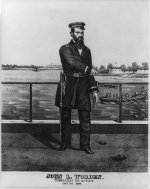jazzeum
Four Star General
- Joined
- Apr 23, 2005
- Messages
- 38,439
March 10, 1862. Lincoln meets with Lt. John L. Worden, commander of the Monitor, the day after the battle.
Worden had been injured in the battle and was resting at the home of Lieut. Henry A. Wise. Worden said to the President: "you do me great honor." Lincoln responded, "It is you who honor me and your country."
Wordent was a veteran Navy officer and he had broken ranks with many of his tradition-bound comrades by embracing the Union ironclad and its inventor, John Ericsson. Although Britain and France had built ironclads, many Navy men still doubted their long-term usefulness, given concerns about speed and logistical support. Skepticism wasn’t limited to the Naval ranks; the press called the Monitor, which sat nearly flush with the waterline, save for a stout circular turret, an “iron coffin.” But Worden saw the Monitor’s revolutionary potential, and he volunteered to command it.
Prior to his command of the Monitor, Woren had been recovering from the effects of seven months spent in an Alabama prison arising out of a mission to the Union naval squadron commander in Pensacola Bay, Florida.
Several weeks after the battle, Worden boarded the Monitor to greet a presidential party that had come to meet the crew and examine their iron seahorse. Harpers Weekly offered the best press accolade: in its March 22 edition, it ran a caption under a picture of Worden that read: “Under Providence: he saved our navy.”
The British also complimented Worden and Ericsson: within days of learning of the battle, the Royal Navy canceled its remaining contracts for new wooden warships. The age of the ironclad had arrived, ushered in by Worden.
Worden never fully recovered from his Monitor wounds, suffering chronic pain, a blind eye and permanent facial markings. Nevertheless, after convalescing he returned to ironclad duty, taking another ship, the Montauk, south to enforce the blockade. In early 1863 he sank the Confederate raider Nashville, and soon after participated in Adm. Samuel F. Du Pont’s ironclad attack on Charleston Bay forts.

John L. Worden, pictured while commander of the ironclad Montauk
Congress passed resolutions honoring him in July 1862 and February1863. After the war Worden served as superintendent of the Naval Academy and commander of the European Squadron as a rear admiral. He died in 1897 and is buried in Pawling, N.Y.
The full article can be accessed here.
Worden had been injured in the battle and was resting at the home of Lieut. Henry A. Wise. Worden said to the President: "you do me great honor." Lincoln responded, "It is you who honor me and your country."
Wordent was a veteran Navy officer and he had broken ranks with many of his tradition-bound comrades by embracing the Union ironclad and its inventor, John Ericsson. Although Britain and France had built ironclads, many Navy men still doubted their long-term usefulness, given concerns about speed and logistical support. Skepticism wasn’t limited to the Naval ranks; the press called the Monitor, which sat nearly flush with the waterline, save for a stout circular turret, an “iron coffin.” But Worden saw the Monitor’s revolutionary potential, and he volunteered to command it.
Prior to his command of the Monitor, Woren had been recovering from the effects of seven months spent in an Alabama prison arising out of a mission to the Union naval squadron commander in Pensacola Bay, Florida.
Several weeks after the battle, Worden boarded the Monitor to greet a presidential party that had come to meet the crew and examine their iron seahorse. Harpers Weekly offered the best press accolade: in its March 22 edition, it ran a caption under a picture of Worden that read: “Under Providence: he saved our navy.”
The British also complimented Worden and Ericsson: within days of learning of the battle, the Royal Navy canceled its remaining contracts for new wooden warships. The age of the ironclad had arrived, ushered in by Worden.
Worden never fully recovered from his Monitor wounds, suffering chronic pain, a blind eye and permanent facial markings. Nevertheless, after convalescing he returned to ironclad duty, taking another ship, the Montauk, south to enforce the blockade. In early 1863 he sank the Confederate raider Nashville, and soon after participated in Adm. Samuel F. Du Pont’s ironclad attack on Charleston Bay forts.

John L. Worden, pictured while commander of the ironclad Montauk
Congress passed resolutions honoring him in July 1862 and February1863. After the war Worden served as superintendent of the Naval Academy and commander of the European Squadron as a rear admiral. He died in 1897 and is buried in Pawling, N.Y.
The full article can be accessed here.

